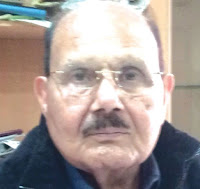Impressed with his honesty and dedication, he was picked by former Prime Minister VP Singh as Joint Secretary in the Prime Minister’s Office. He got the opportunity of working with two prime ministers. He also served as Secretary, Central Vigilance Commission, Secretary in Ministry of Tribal Affairs, Food Corporation of India and Director, Enforcement Directorate. He retired as a Member of the UPSC.
In the Enforcement Directorate, he took action against leading businessmen and investigated the Foreign Exchange Regulation Act (FERA) violations in the 1986 Bofors scam, a job which left him facing CBI questioning for months.
Since 1998, he has been working as the Chairman of the Environment Pollution (Prevention) Control Authority (EPCA) to control all kinds of pollution in the NCR region. He is also a member of the monitoring committee on sealing set up by the Supreme Court.
My interview with him which published on December 2018 in The Statesman where he spoke of how one can control pollution levels in the country. Excerpts:
Q: Air quality index in the NCR region has deteriorated sharply during the past few years. It has started affecting public health and is reducing life span in the Capital. What steps has EPCA taken to bring relief to people in the NCR region?
A: Pollution level, mainly air quality, has reached an alarming stage in the capital. We have taken a series of steps to bring down pollution in the region and prepared a Graded Response Action Plan (GRAP) after evaluating pollution in the NCR. GRAP lists a series of public actions and effective steps to combat public health emergencies due to pollution. This has started showing results as well. This year the air quality situation is much better than in the last few years. Yet there are a lot of steps that need to be taken to fight pollution in the country and stop further degeneration of air quality.
The analysis of air quality trend shows that ‘severe’ and ‘very poor’ air quality is anticipated throughout the winter months from November to February and largely ‘poor’ category during the summer months of March to May. We have prepared a roadmap keeping in view the key pollution sources in Delhi and the National Capital Region of Delhi (NCR). On the basis of air quality emergencies, the CPCB headed task force suggests additional special measures that are required to bring down the air pollution levels to desired levels.
Q: Are you happy with the efforts taken by state authorities in controlling pollution?
A: This year winter air quality is not up to the mark, but still it is satisfactory when we compare it to the last few years. This shows that authorities in the NCR region are doing their best to improve air quality. But still, there is a lot more that needs to be done. State enforcing agencies should take it up as a mission and all missing links should be taken care of. They should ensure that air quality does not worsen further and be strict against those violating pollution norms.
Q: What other steps do you suggest should be taken to make NCR region less polluted?
A: When air quality index reaches an alarming level, we have to take harsh measures including a temporary ban on entry of trucks in Delhi, except emergency and essential services, and also stop construction work. Though this affects business activities, we take this decision keeping public health in mind.
Similarly, private vehicles are one of the main reasons for pollution in the Capital. The need of the hour is to put some kind of restrictions on the use of private vehicles and promote public transport system. It would not only reduce pollution but also lead to decongestion of roads. Imagine a car carries a maximum four to five persons whereas a bus carries nearly 60 to 70 people.
And I do not buy the argument that it would cause inconvenience… if we can stop the entry of trucks or construction work for public health, we can do this as well. Authorities and civil society should educate people to give up vehicles for a better environment and for a better future for our young generation.
Parking is another problem due to private vehicles, people have converted vehicle garages into residential areas or shops and park on the road. We suggest two to three times hike in parking fees. Those who have cars should bear the burden, imagine the value of public land being used as car parks. And why should it not be charged from the car owners?
Q: Another reason for the increase in pollution level is stubble burning in neighbouring areas. The government had initiated action against those involved in stubble burning. Do you think the steps are sufficient?
A: The government should adopt a carrot and stick policy. Wrongdoers must be punished. There must be exemplary punitive action against those who burn stubble. And at the same time, farmers should be given subsidies to procure appliances like happy seeder, rotavator and mulcher that helps in converting stubble into manure. Industries which use stubble as raw material need to be promoted, it can be used as fuel, for making alcohol, and other products. Farmers must be given an economical model to use fodder in a profitable way.
Q: Besides government initiatives what else do you suggest to improve the pollution level in the NCR region?
A: Though government and law enforcing agencies are doing their work, no work is complete without the participation of civil society. It is time that civil society joins in and takes it up as a mission to ensure the health and pollution-free atmosphere in the region. Rather I would say NGOs have more of a role to play than government in educating people on the harmful effects of pollution. They can also take the initiative to recycle urban as well as rural waste into some useful products.








